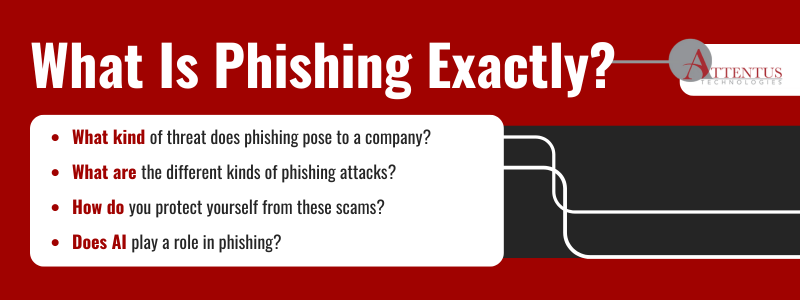Understand the many serious threats posed by phishing and how to protect your company from them
We’ve all heard talk of phishing scams and social engineering attacks—devious new ways for hackers to access our personal information. The FBI San Francisco division recently warned of the “escalating threat posed by cyber criminals utilizing artificial intelligence (AI) tools to conduct sophisticated phishing/social engineering attacks and voice/video cloning scams.”
So, what is phishing, and how do you protect yourself?
What is phishing?
Phishing is a social engineering attack where an attacker poses as a legitimate or trusted source to trick individuals into revealing sensitive information, such as usernames, passwords, or credit card details. These attacks typically involve sending large volumes of deceptive emails that bypass spam filters and lure recipients into providing their private data.
Phishing emails can look like they’re from Facebook, X, or LinkedIn and ask you for a password reset, which requires your username. Just like that, the hacker has access to your account, which includes all of your personal data: your home address, your workplace (where they now know they have an easy target: you), and even your likes or dislikes. With this information, bad actors can further target you and your connections for other scams.
According to IBM, phishing is the most common type of data breach attack in the United States, costing businesses an average of $4.76 million.
Phishing criminals hide behind trusted names
Even more nefarious is when phishing scams pose as a more influential organization: your bank, for example. The email could have a subject line that reads “Unauthorized Account Access: Immediate Action Required” and ask for your username, password, PIN, and account number.
Before you know it, you’ve been robbed and locked out of your account. Similar attacks could also ask for your social security number, which opens the door for identity theft — a life-destroying crime.
When you receive a phishing email, few people would blame you for being tricked. These emails will often have the exact presentation of an official email from that source, down to the signatures and layout. The link they provide will bring you to a website that looks entirely legitimate and will make you feel safe in divulging your data.
Because the attacks involve tricking people, automatic cybersecurity measures can’t always detect them.
Different types of phishing attacks
Since 90% of successful hacks and data breaches begin with phishing scams, it’s clear that anyone can fall victim to them. These attacks aren’t limited to email; they can also occur through voice phishing (vishing), where the scam happens over a phone call, or SMS phishing (smishing), which targets victims through text messages, especially as more companies use text-based services. Additionally, different types of malware and ransomware can achieve similar harmful outcomes by compromising sensitive data.
Common types of phishing attacks include:
- Spear phishing — This fools receivers with subject matter that seems to directly come from the business, such as a directive from HR or the company leadership
- Pretexting — Stolen personal data is used to convince the recipient that the email or text message is legitimate
- Rogue — Fake antivirus software is used to gain access to computers and networks
- Waterholing—Hackers gain access to a company and its employees and steal personal authentication information.
- Whaling—These are attacks focused on a company’s senior leadership
- Smishing and vishing—These use telephone calls and texts as the method of communication.
- Angler phishing—People are tricked through social media, and the attacks often use personal information posted online to create highly targeted attacks.
- AI-powered voice and video cloning techniques—These enable cybercriminals to impersonate people you trust, such as family members, friends, and co-workers.
So, how do you keep yourself safe from phishing?
There are a few easy solutions, and the most basic is to think before you click.
If you know you haven’t requested a password reset for any of your accounts, you should be suspicious if one comes in. Another easy adaptation (one that helps protect you from a variety of hacking attempts) is to enable multi-factor authentication on your accounts, such as text confirmation or some kind of fingerprint scan.
If you receive a password reset request for an account you haven’t tried to reset, be cautious—it could be a phishing attempt. Another simple way to protect yourself from various hacking methods is to enable multi-factor authentication (MFA) on your accounts. This adds an extra layer of security by requiring additional verification, like a text confirmation or fingerprint scan, before granting access According to research by Google, multi-factor authentication can prevent as much as 99% of phishing attacks in bulk and 100% of automated bot attacks.If it doesn’t match up, don’t interact with it any further.
According to the U.K.’s National Cyber Security Centre, businesses should take a multilayered approach to protecting themselves that includes:
- Making it hard for attackers to communicate with your staff and leadership
- Educating users to identify and report suspected phishing messages
- Putting protections in place to insulate your company from the consequences of phishing attack
- Instituting a quick response plan to successful phishing attempts
Depend on a reliable I.T. partner for help
To ensure no one in your organization falls victim to a phishing attack, you should work with a technology expert to develop a documented security policy and share it with your team. Once the policy is developed and shared, regular training should be scheduled to ensure that the policy is adhered to regularly. Attentus can help by providing comprehensive training to your staff, so they know what to look out for and can recognize phishing attempts before any damage is done.
A phishing attack can victimize anyone. Fostering trust is essential to our approach at Attentus. We understand that trust builds strong relationships and streamlines communication, making everything run more smoothly and efficiently. Building trusted relationships is one of our core values, and we see our partners’ success as our success. Our commitment is to follow through on our promises and address any issues swiftly and transparently. When it comes to safeguarding your business from phishing and other cybersecurity threats, you can trust Attentus to be your reliable partner, always ready to help.
Contact us if you’re interested in a robust and reliable I.T. partner who can help you navigate the dangerous waters of modern online security.


